Ramp is a busy place with lots of movement of men and machines. However, it is important to spread awareness about ramp safety by identifying the ramp hazards at an airport and the safety precautions needed to mitigate such hazards.
Therefore, our today’s article is dedicated to explaining some important hazards to be kept in mind when working on the ramp or managing ramp operations. The hazards that we have discussed here apply to multiple ground handling operations and are not specific to any one job.
Faded Ground Markings on a Ramp
We have already discussed the importance of ground markings on the ramp that define its layout. These ground markings carry meaning and serve almost as a language on airside. This language is interpreted by staff working on airside to carry out operation safely.
The ground markings on the ramp give a clear visual cue to the ramp workers regarding how to work on the ramp. However, ground markings need maintenance too. They are not a one-time job where these lines are painted on ground and then they remain there forever.
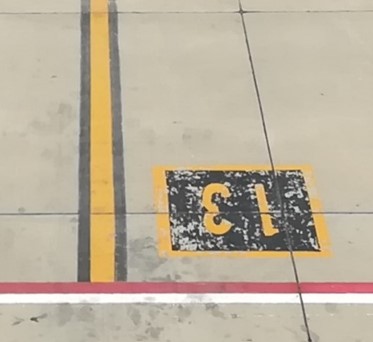

Over time, the paint of these ground markings fades away and needs refreshing. Faded ground markings have the potential to cause confusion during ramp operations are result in any safety breach. It is especially important during night when visibility is already low.
For example, if the parking zone of the jet bridge has faded, jet bridge operator will find it difficult to park the bridge at night. Similarly, if the Equipment Staging Area (ESA) ground markings have faded, ground handling agents may mistakenly park ground support equipment (GSE) somewhere it is not supposed to be parked.
Airports have airside management section that is responsible for inspection of condition of ground markings not only on ramp but overall on an airport’s airside. In case any ground marking is found faded, it is refreshed by applying fresh paint.
Hot Aircraft Parts – Scorching Hazard
All ramp workers must be trained to understand that certain parts of the aircraft parked on the ramp can be extremely hot to the touch and are easily accessible for ramp personnel.
In this regard, Jet Engine’s nozzle is a smoking gun when an aircraft reaches the aircraft stand because they have just been recently turned off but it takes time for the metal to cool down. It can have a temperature of several hundred degrees Celsius on the ramp.
Apart from above, there are two main factors that makes jet engine nozzle’s a serious ramp hazard. First, a lot of ramp workers work around the jet engine. It is a part that has a lot of movement around its surrounding. Secondly, it is easily accessible to everyone i.e., it is not like some internal component that a maintenance technician can reach after disassembling a few parts. It is right there in front of everyone.
The above two factors make jet engine nozzles a serious safety hazard on the ramp.
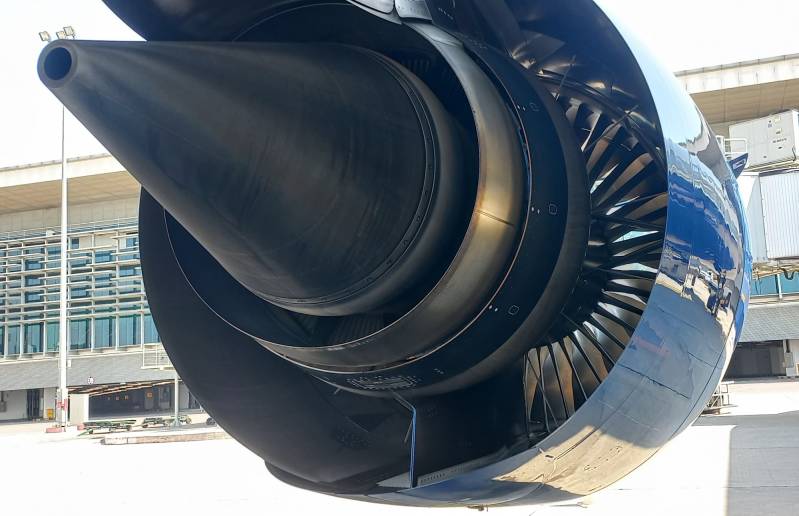
Apart from above, aircraft landing gear has brakes that slow the aircraft down during landing and also when the aircraft parks on the ramp.
These brake assemblies are extremely hot because they go through a lot of friction during landing. Their temperature remains high long after an aircraft has stopped. If any ramp worker makes contact with them with his body, he will receive serious burns.
The hot landing gear brakes are most hazardous for aircraft refuel crews because they have to engage the bonding cable of the refuel vehicle with the landing gear. Therefore, care has to be exercised to keep ramp personnel safe from burning or scorching themselves.

Ramp Hazards in Adverse Weather Conditions
Adverse weather conditions also necessitate additional safety precautions to be taken by ground handling agents on the ramp. Every operation has sensitivities to severe weather and such precautions must be made part of training of ramp workers and ramp crews.
Aircraft tie down procedures are undertaken in case of severe windstorms especially for smaller aircrafts in which they are tied down to on-ground hooks. That is so because an aircraft has an aerodynamically optimized body, and it is very responsive to air passing over it at high speed.

High speed winds can move the aircraft and cause it to collide with any nearby object or building. Therefore, aircraft tie down procedure is important whenever a weather warning is received at the airport in which the forecasted windspeed is abnormally high.
Generally, windspeeds of above 40 knots is dangerous for smaller parked aircrafts while windspeed of above 50 knots (57.5 miles per hour) is dangerous for larger parked aircrafts. Once ground windspeed hits above 60 knots, it becomes dangerous even for widebody aircrafts parked on the apron.
What winds can do to smaller aircrafts parked on a ramp (Video Credit: YouTube Channel “LOWSOE”)
Apart from above, some aircraft ground operations are suspended under severe weather conditions. For example, aircraft refueling is suspended if there is risk of severe electrical storms. Similarly, operation of catering truck is also suspended if the wind reaches a speed greater than the capacity of catering truck.
In the same way, jet bridges also have a maximum wind rating over which they must not be operated. Under severe wind conditions, jet bridges must be retracted with chocks applied on their wheels to prevent movement due to wind forces.
A ramp worker must also remain standby for disconnecting Aircraft Ground Power (GPU) cable and Preconditioned Air (PCA) hose if the wind speeds are causing them to sway abnormally as it can damage the aircraft GPU and PCA receptacle because of abnormal forces acting on the adapters.
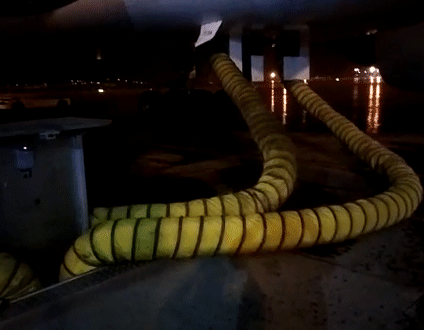
Hazard of Short Circuiting & Weatherproofing of Ramp Equipment
Most of the ground support equipment (GSE) used on the ramp are designed to remain usable under rain and snow. It is due to the fact that airports experience such weather conditions are flights are not cancelled just because of it is raining or snowing.
All modern ground support equipment are designed with weather protection features especially waterproofing to offer protection from rain up to a certain level.
For example, Aircraft Ground Power (GPU) receptacle and cable are waterproof, and the GPU can remain connected even under heavy rain. Similarly, ground airconditioning (PCA) hose is also made waterproof such that rainwater does not pass through the hose fabric to be carried with air inside the aircraft.
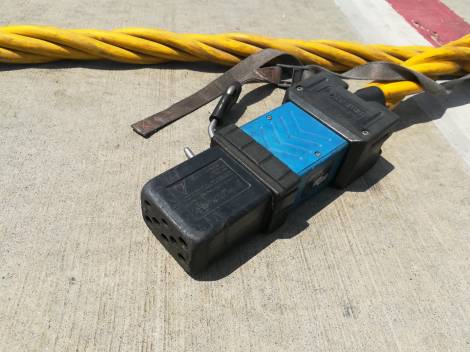

Electric motors, sensors and other sensitive electrical and electronic components installed on the exterior side of a jet bridge are also made waterproof such that the jet bridge does not experience any abnormality because of rainwater short circuiting its motors or sensors.
However, this weather protection is in-built into these equipment with the help of design features in which the most notable is a rubber seals present in all crevices and openings of components and assemblies from where rainwater can enter.
These seals can wear out over time just as part of their natural life or since maintenance teams disassemble and reassemble many components as part of their maintenance. Therefore, it is extremely important that maintenance teams make sure the weather protection of these equipment and components is intact.
Checking the components for water ingress protection and weather proofing must be made part of maintenance checklists of all sensitive assemblies to make sure rainwater does not cause any abnormal behavior of equipment on the ramp.
Weather protection seals must be kept in stock for ready replacement of defective seals as a part of maintaining the weather protection features of ground support equipment.
Hazards of Work Fatigue & Importance of Ramp Workers Fitness
An element that is sometimes overlooked when ramp safety is discussed is the importance of ramp staff fitness. Ramp operations require physical fitness of ramp workers. It becomes evident by reviewing the nature of many of the different ramp operations.
Widebody aircrafts have GPU receptacle at a height where the worker needs to climb a ladder and properly insert the GPU adapter into the receptacle. For climbing the ladder, he has to bring the ladder to the ramp as well and unload it from the vehicle.

Preconditioned air (PCA) receptacle on some narrowbody aircrafts is located at such a height that ramp worker would have to duck and squat into a tight position for him to be able to properly plug the hose inside the receptacle.

Baggage loaders have to manually unload the bags from the baggage cart on to the conveyor belt. Bags can be of different sizes and weights and there is no automation in this task. Similarly, the other ramp worker who receives the bags inside the cargo compartment has to sort the baggage properly inside the aircraft. On arrivals, the same procedure is reversed. Cargo loading crew has to push the ULDs on to the cargo loader after they have manually loaded the ULDs with luggage and cargo consignments from the airport’s baggage belts.
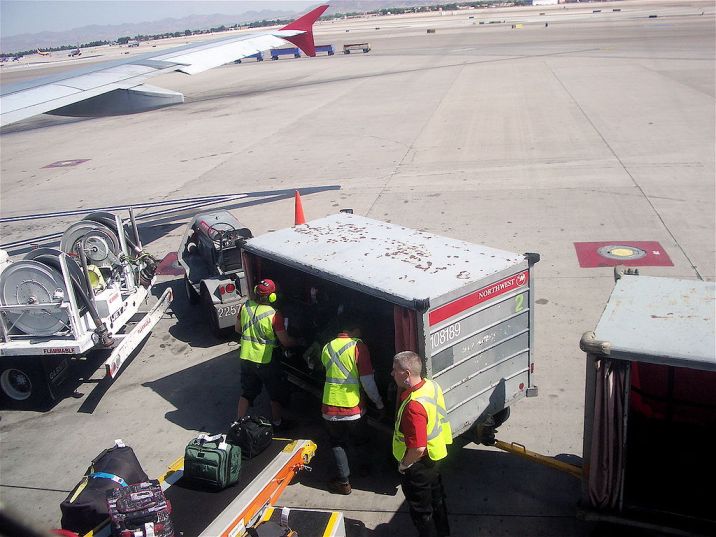
Ramp workers who are suffering from any injury or are physically unfit cannot be relied upon to carry out such tasks as there would be risk of them causing some accident or injuring their own selves during work.
Apart from the inherent physical nature of these works, also consider that airports run operations 24/7. Ramp workers who are carrying out these jobs are working in day and night shifts. This shifts duty further supplements the already straining nature of these jobs.
It is therefore important that ramp workers are physically fit so they can be relied upon to carry out these jobs safely. This physical fitness is not as stringent (as if in the military), however a general consideration on height and weight must be given during hiring ramp workers.
Similarly, any ramp worker who is injured in a way that he finds it difficult to perform physical tasks must not be permitted to work on the ramp.
Last but not the least, certain health conditions put people at a disadvantage to perform certain tasks. Most notably, people with diabetes find it very difficult to maintain their health while working in shifts. A low blood sugar on ramp would cause the worker to collapse which is extremely dangerous for the safety of the worker and the people around him.
Therefore, many organizations disallow deploying people with diabetes on certain jobs like jet bridge operation which in itself is not strenuous in nature. However, the risk of a person fainting or collapsing due to blood sugar level and therefore losing control of equipment in the vicinity of the aircraft poses great risk of a ramp accident.
Apart from these fitness aspects, certain external conditions can also affect physical fitness of workers. For example, airports located in extremely hot climates wear down the energy level of ramp workers. A drained energy level affects the alertness of ramp workers that is critical for ramp safety. Airports where such conditions exist must take measures to counter this effect.
A good remedial is to shorten the shift timings so that fresh team takes over the charge before the existing team wears down. For example, if normally the airport is running 6-hour shifts throughout the year, the same may be converted to 5-hour shifts during the summers.
Another external factor is the workplace environment. It includes proper air conditioning in operations control rooms where workers report back after operations. It also includes the availability of rest rooms where workers may take short breaks from work. Consideration of human factors is of critical importance for ensuring ramp safety.
If you liked this article, share it with at least one person of common interest. It allows our work to be of service to people who can benefit from it the most.
If you are interested in obtaining a base level knowledge about ramp safety, check out this 7-hour video based course on Udemy that you can easily finish in a week (or binge watch in a day or two). It explains ramp safety in detail with interesting case studies of ramp accidents for in-depth understanding of the subject. It also explains ramp safety aspects associated with 13 main ground handling operations carried out on the ramp.